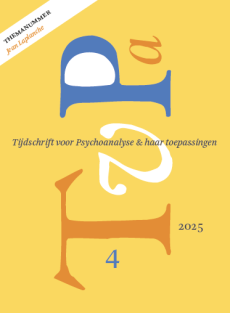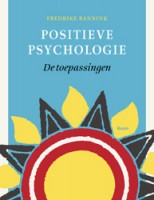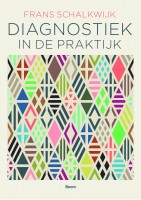Hechtingstheorie en psychoanalyse
Summary
Bowlbys attachment theory was not to be reconciled with the basic assumptions of metapsychology: the economic and the dynamic points of view. However, over recent decades both the empirical and academic as well as the intersubjective trends in psychoanalysis have relied heavily on attachment theory and research. On the other hand, the significance of attachment theory for psychoanalysis remains controversial. From the overview that this article gives of the complex relationship between psychoanalysis and attachment theory, the conclusion may be drawn that traditional psychoanalytic theory needs to expand and integrate relevant issues that have emerged from research on attachment development. In using these issues, it remains important to preserve the essentials of psychoanalysis in clinical practice, and especially in empathy with the violent emotions, pains and fears that accompany emotional development.
Literatuur
- Abrams, S. (2001). Summation: Unrealized Possibilities. Psychoanalytic Study of the Child, 56, 105-119.
- Akhtar, S. (1999). Distinguishing needs from wishes. Journal of the American Psychoanalytic Association, 47 (1), 113-152.
- Balint, M. (1937). Early developmental states of the ego. Primary object love. In M. Balint, Primary love and psychoanalytic technique (p. 234-267). Londen: Tavistock, 1965.
- Beebe, B. & Lachman, F. (2002). Infant Research and Adult Treatment. Co-constructing Interactions. Hillsdale NJ/Londen: The Analytic Press.
- Berkouwer, A.Y. (2003). De analyticus als ontwikkelingsobject. In M.G.J. Schmeets & A.P. Schut (red.), Anders en toch hetzelfde. NPI-reeks (p. 107-119). Assen: Van Gorcum.
- Bowlby, J. (1944). Forty-four juvenile thieves: Their characters and home life. International Journal of Psychoanalysis, 25, 19-52, 587-591.
- Bowlby, J. (1958). The nature of the childs tie to his mother. International Journal of Psychoanalysis, 39, 350-373.
- Bowlby, J. (1960). Grief and mourning in infancy. Psychoanalytic Study of the Child, 15, 3-39.
- Bram, D.A. & Gabbard, G.O. (2001). Potential Space and Reflective Functioning. International Journal of Psychoanalysis, 82, 685-699.
- Bruschweiler-Stern, N. (2002). Explicating the implicit: the local level and the microprocess of change in the analytic situation. International Journal of Psychoanalysis, 83, 1051-1062.
- Buchheim, A. & Kächele, H. (2002). Das Adult Attachment Interview und psychoanalytisches Verstehen: Ein klinischer Dialog. Psyche, 56, 946-973.
- Cavell, M. (1998). Triangulation, ones own mind, and objectivity. International Journal of Psychoanalysis, 79, 217-233.
- Chused Fingert, J. (2000). Discussion: A Clinicians View of Attachment Theory. Journal of the American Psychoanalytic Association, 4, 1175-1189.
- Cohen, Y. (1997). Attachment and Psychopathological Development. Psychoanalytic Study of the Child, 52, 247-259.
- Crittenden, P. (1988). Internal representational models of attachment relationships. Infant Mental Health Journal, 11, 259-277.
- Deben-Mager, M. (2002). Geheugen en therapeutisch handelen. Mededelingenblad Nederlandse Vereniging voor Psychoanalyse, 17 (4), 90-97.
- Emde, R. (1999). Moving Ahead: Integrating Influences of Affective Processes for Development and for Psychoanalysis. International Journal of Psychoanalysis, 80, 317-339.
- Fonagy, P. (1982). The integration of psychoanalysis and experimental science. International Review of Psychoanalysis, 9, 125-145.
- Fonagy, P. (2001). Attachment theory and psychoanalysis. New York: Other Press.
- Fonagy, P., Moran, G.S., Edgcumbe, R., Kennedy, H., Target, M. (1993). The Roles of Mental Representations and Mental Processes in Therapeutic Action. Psychoanalytic Study of the Child, 48, 9-49.
- Fonagy, P., Gergely, G., Jurist, E.L., Target, M. (2002). Affect Regulation, Mentalization and the Development of the Self. New York: Other Press.
- Freud, A. (1960). Discussion of Dr. John Bowlbys paper. Psychoanalytic Study of the Child, 15, 53-62.
- Freud, A. (1965). Normality and Pathology. New York: International Universities Press.
- Freud, S. (1905). Drei Abhandlungen Zur sexualtheorie. Studienausgabe (p. 37-148). Frankfurt am Main: S. Fischer Verlag.
- Gergely, G. (2000). Reapproaching Mahler: New perspectives on normal autism, symbiosis, splitting, and libidinal object constancy from cognitive developmental theory. Journal of the American Psychoanalytic Association, 48 (4), 1197-1229.
- Green, A. (2000). Science and science fiction in infant research. In J. Sandler, A.M. Sandler, R. Davies (red.), Clinical and Observational Psychonalytic Research (p. 41-72). Londen: Monograph Series of the Psychoanalysis Unit of University College/The Anna Freud Centre.
- Green, A. (2002). A Dual Conception of Narcissism. Psychoanalytic Quarterly, 71 (4), 631-651.
- Hermann, I. (1936). Clinging-Going in Search. Psychoanalytic Quarterly, 1976, 45 (1), 1-36.
- Hesse, E. & Main, M. (2000). Disorganized infant, child, and adult attachment: collapse in behavioural and attentional strategies. Journal of the American Psychoanalytic Association, 48 (4), 1097-1120.
- Holmes, J. (1996). Attachment, Intimacy, Autonomy. Northvale NJ/Londen: Jason Aronson.
- Holmes, J. (1998). The changing aims of psychoanalytic psychotherapy. International Journal of Psychoanalysis, 79, 227-240.
- Hurry, A. (red.) (1998). Psychoanalysis and Developmental Therapy. Londen: Karnac Books.
- Inderbitzin, L.B. & Levy, S.T. (2000). Regression of Psychoanalytic Technique. Psychoanalytic Quarterly, 59 (2), 195-223.
- Jongbloed, D. (1998). De analyticus als real object. In J. Baneke, A. Ladan, N. Treurniet, M. Visser-Donker (red.), Trauma en Identiteit. Assen: Van Gorcum.
- Kandel, E.R. (1998). A new intellectual framework for psychiatry. American Journal of Psychiatry, 155, 457-469.
- Kandel, E.R. (1999). Biology and the future of psychoanalysis: A new intellectual framework for psychiatry revisited. American Journal of Psychiatry, 156, 228-247.
- Kobak, R. (1999). The emotional dynamics of disruptions in attachment relationships. Implications for theory, research and clinical intervention. In J. Cassidy & P.R. Shaver (red.), Handbook of Attachment (p. 21-24). Londen: Guilford Press.
- Laplanche, J. (1997). The theory of seduction and the problem of the other. International Journal of Psychoanalysis, 78, 653-666.
- Laplanche, J. (2001). Sexuality and Attachment in Metapsychology. In D. Widlöcher (red.), Infantile Sexuality and Attachment. New York: Other Press.
- Leeuw, P.J. van der (1967). Over Freuds theorievorming. In P.J. van der Leeuw e.a., Hoofdstukken uit de hedendaagse psychoanalyse (p. 31-57). Arnhem: Van Loghum Slaterus.
- Lyons Ruth, K. (1991). Rapprochement or approchement: Mahlers theory reconsidered from the vantage point of recent research in early attachment relationships. Psychoanalytic Psychology, 8, 1-23.
- Magai, C. (1999). Affect, Imagery, and Attachment. In J. Cassidy & P.R. Shaver (red.), Handbook of Attachment (p. 803-823). New York/Londen: Guilford Press.
- Mahler, M., Pine, F. & Bergman, A. (1975). The psychological birth of the human infant. New York: Basic Books.
- Main, M. (2000). The organized categories of infant, child, and adult attachment: flexible vs. inflexible attention under attachment-related stress. Journal of the American Psychoanalytic Association, 48 (4), 1055-1096.
- Marvin, R.S. & Britner, P.A. (1999). Normative Development. The Ontogeny of Attachment. In J. Cassidy & P.R. Shaver (red.), Handbook of Attachment (p. 44-68). New York/Londen: Guilford Press.
- Mitchell, S.A. (2000). Relationality. From Attachment to Intersubjectivity. Hillsdale NJ/Londen: The Analytic Press.
- Neubauer, P.B. (2001). Emerging Issues: Some Observations about Changes in Technique in Child Analysis. Psychoanalytic Study of the Child, 56, 16-27.
- Novick, J. & Novick, K.K. (1987). The Essence of Masochism. Psychoanalytic Study of the Child, 42, 353-385.
- Rudnytsky, P.L. (1997). The Personal Origins of Attachment Theory: An Interview with Mary Salter Ainsworth. Psychoanalytic Study of the Child, 52, 387-405.
- Sandler, J. (1987). From safety to superego. Selected papers of Joseph Sandler. New York: Guilford Press.
- Schmeets, M.G.J. & Reekum, A.C. van (2000). Psychotherapie en haar toekomst binnen de psychiatrie. Een poging tot integratie van nieuwe inzichten. Tijdschrift voor psychiatrie, 42, 459-467.
- Schore, A.N. (1994). Psychoanalysis and neurobiology. Journal of the American Psychoanalytic Association, 45 (3), 807-840.
- Schore, A.N. (2002). Attachment Theory, and Trauma Research: Implications for self-psychology. Psychoanalytic Inquiry, 22 (3), 433-484.
- Schuengel, C, Bakermans-Kranenburg, M.J., IJzendoorn, M.H. van, Blom, M. (1999). Unresolved loss and infant disorganisation: links to frightening maternal behavior. In J. Solomon & C. George (red.), Attachment Disorganization (p. 71-94). New York: Guilford Press.
- Silverman, D.K. (2001). Sexuality and Attachment: A Passionate Relationship or a Marriage of Convenience. Psychoanalytic Quarterly, 70 (2), 325-359.
- Slade, A. (2000). The development & organisation of attachment. Journal of the American Psychoanalytic Association, 84 (4), 1147-1175.
- Slade, A. (2002). Niet gepubliceerd. Symposium on Maternal Reflective Functioning: Attachment and Caregiving. 8e WAIMH-Congres, Amsterdam.
- Squires, C. (2001). Attachment and Infantile Sexuality. In D. Widlöcher (red.), Infantile Sexuality and Attachment (p. 133-157). New York: Other Press.
- Sroufe, L.A. & Waters, E. (1977). Attachment as an organizational construct. Child Development, 48, 1184-1199.
- Sroufe, L.A., Carlson, E.A., Levy, A.K., Egeland, B. (1999). Implications of attachment theory for developmental psychopathology. Development and Psychopathology, 11, 1-13.
- Stein, R. (1998). The Enigmatic Dimension of Sexual Experience: The Otherness of Sexuality and Primal Seduction. Psychoanalytic Quarterly, 67 (4), 594-626.
- Stern, D.N. (2002). Niet gepubliceerd. Discussie na Symposium on Parents Representations. 8e WAIMH-congres, Amsterdam
- Treurniet, N. (1984). Over recente ontwikkelingen van het psychoanalytisch denken. Tijdschrift voor Psychotherapie, 10 (4), 232-275.
- Tronick, E. (2002). Niet gepubliceerd. How can the infants relationship with the mother the infants most differentiated, specific, and thick relationship, serve as the prototype for other relationships and attachments? Conversation Hour, WAIMH-congres te Amsterdam
- Vliegen, N., Meurs, P., Gluckers G. (2002). Hoe moeders in beeld blijven. Robert Emdes visie op de ontwikkeling van moederbeelden en zelfrepresentaties. Tijdschrift voor Psychoanalyse, 8 (4), 205-222.
- Waal, J. de (2002). In den beginne was er hechting ... De waarde van theorieën over de hechtingsstijlen voor de psychotherapeutische behandeling en indicatiestelling. Tijdschrift voor Psychotherapie, 28, 483-500.
- Widlöcher, D. (2001). Infantile Sexuality and Attachment. New York: Other Press.
- Wolff, P.H. (1996). The Irrelevance of Infant Observation for Psychoanalysis. Journal of the American Psychoanalytic Association, 44 (2), 369-474.
- Yorke, C. (1990). The Development and Functioning of the Sense of Shame. Psychoanalytic Study of the Child, 45, 377-411.
- Yorke, C. (1995). Freuds Psychology: Can It Survive? Psychoanalytic Study of the Child, 50, 3-32.
 © 2009-2025 Uitgeverij Boom Amsterdam
© 2009-2025 Uitgeverij Boom Amsterdam
ISSN 1382-516x
De artikelen uit de (online)tijdschriften van Uitgeverij Boom zijn auteursrechtelijk beschermd. U kunt er natuurlijk uit citeren (voorzien van een bronvermelding) maar voor reproductie in welke vorm dan ook moet toestemming aan de uitgever worden gevraagd:
Behoudens de in of krachtens de Auteurswet van 1912 gestelde uitzonderingen mag niets uit deze uitgave worden verveelvoudigd, opgeslagen in een geautomatiseerd gegevensbestand, of openbaar gemaakt, in enige vorm of op enige wijze, hetzij elektronisch, mechanisch door fotokopieën, opnamen of enig andere manier, zonder voorafgaande schriftelijke toestemming van de uitgever.
Voor zover het maken van kopieën uit deze uitgave is toegestaan op grond van artikelen 16h t/m 16m Auteurswet 1912 jo. Besluit van 27 november 2002, Stb 575, dient men de daarvoor wettelijk verschuldigde vergoeding te voldoen aan de Stichting Reprorecht te Hoofddorp (postbus 3060, 2130 KB, www.reprorecht.nl) of contact op te nemen met de uitgever voor het treffen van een rechtstreekse regeling in de zin van art. 16l, vijfde lid, Auteurswet 1912.
Voor het overnemen van gedeelte(n) uit deze uitgave in bloemlezingen, readers en andere compilatiewerken (artikel 16, Auteurswet 1912) kan men zich wenden tot de Stichting PRO (Stichting Publicatie- en Reproductierechten, postbus 3060, 2130 KB Hoofddorp, www.cedar.nl/pro).
No part of this book may be reproduced in any way whatsoever without the written permission of the publisher.
Nieuwsbrief Boom Psychologie
Meld u nu aan en ontvang maandelijks de Boom Psychologie nieuwsbrief met aantrekkelijke aanbiedingen en de nieuwe uitgaven.
Aanmelden


